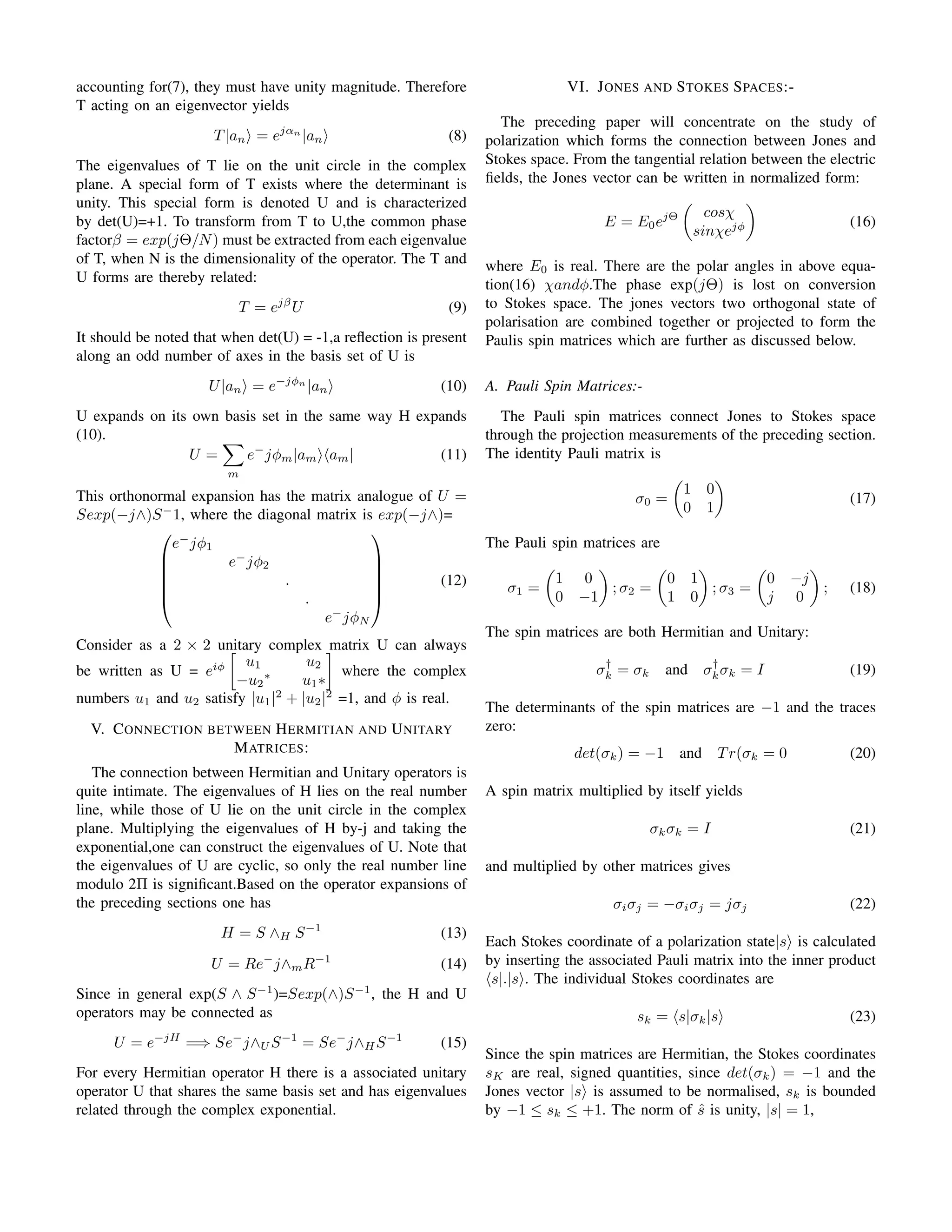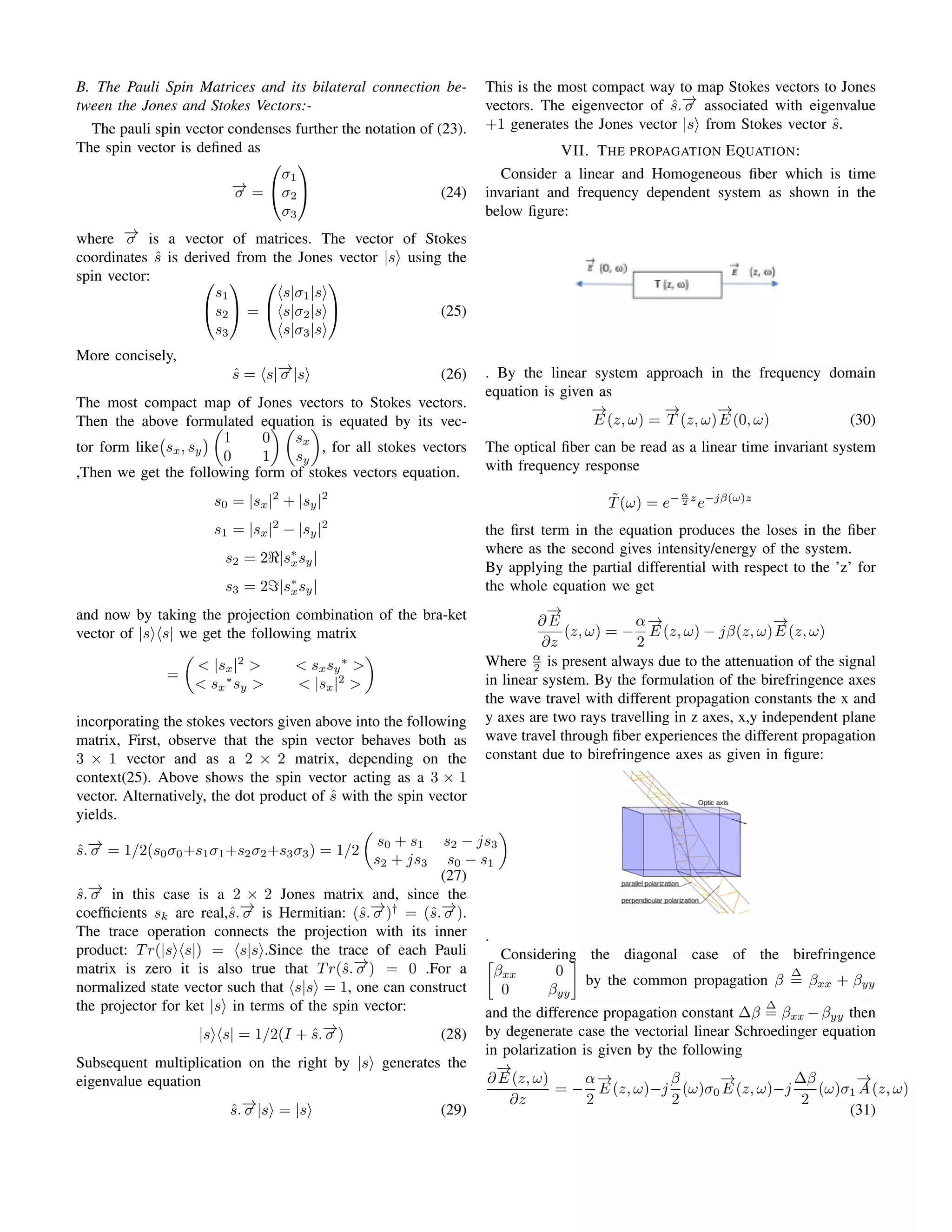This report discusses the fundamental concepts of polarization mode dispersion in optical fibers, connecting various methodologies in Jones and Stokes spaces using a unified notation. It elaborates on properties of Hermitian and unitary matrices, the significance of Pauli spin matrices in describing polarization, and the propagation equations within optical fibers. The paper emphasizes the relationship between Jones vectors and Stokes vectors through projections and mathematical transformations.



![We are interested in the propagation of an optical field along
single mode optical fibers (SMF),we will deal with a general
linear optical system.
Let’s begin with the frequency domain description of the
complex field envelop along a linear loseless optical system
with possibly z-varying characteristics the equation given in
(30)
e
E(z, ω) = T(z, ω) e
E(0, ω)
where T is the input/output system matrix, from the input
(z = 0) to the point at coordinate z. Such matrix is known as
the Jones matrix of the system. Matrix T is unitary because of
the lossless requirement, i.e, T−1
= T†1
. This comes from the
fact that E2
(z, ω) = e
E(z, ω)
†
e
E(z, ω) is constant in z, which
by(30) implies T†
T is constant in z, and equals its value at
z=0, i.e. the identity matrix because a zero length fiber does
not alter the field. Properties of unitary and other matrices
widely used in this paper are summarized above. Taking the
derivative with respect to z of both sides of(30) gives.
∂ e
E(z, ω)
∂z
=
∂T(z, ω)
∂z
e
E(0, ω) (32)
and inverting(30) to express e
E(0, ω) in (32) which is always
possible except for the ideal polarizers gives
∂ e
E(z, ω)
∂z
= M(z, ω) e
E(0, ω) (33)
where
M(z, ω)
∆
=
∂T(z, ω)
∂z
T−1
(z, ω) (34)
is the local propagation matrix at coordinate z. The global
matrix T is thus the unique solution to the matrix equation.
∂T(z, ω)
∂z
= M(z, ω)T(z, ω), T(0, ω) = I (35)
Matrix M is skew-hermitian. In fact from(18) and its conjugate
transpose we get:
0 =
∂| e
E(z, ω)|2
∂z
=
∂ e
E
†
∂z
e
E + e
E
† ∂ e
E
∂z
(36)
= e
E
†
M† e
E + e
E
†
M e
E
= e
E
†
(M†
+ M) e
E
which is true for every e
E, hence it must be: M†
= −M. The
eigenmodes of M(z, ω) are called the local birefringence axes
of the system. Using the results in unitary matrix, we spec-
trally decompose M using the unitary matrix L
∆
= [L̂, ˆ
L0]of
its orthonormal birefringence axes, and its associated purely
imaginary eigenvalues −iβ, −iβ2
, being the propagation con-
stants β(z, ω) and β(z, ω) positive numbers, as:
M(z, ω) = −L(z, ω)
iβ(z, ω) 0
0 iβ0(z, ω)
L†
(z, ω)
(37)
and we labelled the two eigenvalues such that the birefringence
strength ∆β(z, ω)
∆
= β − β0 is positive at the frequency.
This amounts to assuming that the first axis L̂ has a lower
propagation speed than the other. We call it the slow
birefringence axis as shown in the figure.
. It is known from system theory that the matrix solution of
(35) satisfies:
det(T(z, ω)) = e
R z
0
T r[M(ζ,ω)]dζ
= e−i
R z
0
(β(ζ,ω)+β0(ζ,ω))dζ
(38)
being Tr(.) is the trace operator, which verifies that the
determinant of T has unity magnitude. It is also known that if
matrices M(z, ω)and
R z
0
M(ζ, ω)dζ commute for all z, then
the Jones matrix T, solution of (35), has the matrix exponential
form:
T(z, ω) = e
R z
0
M(ζ,ω)dζ
T(0, ω) = e
R z
0
M(ζ,ω)dζ
(39)
This is clearly the case when the birefringence axes do not
vary in z, i.e. L(z, ω) = L(ω), which corresponds to a z-
homogeneous fiber which we call a generalized polarization
maintaining fiber(GPMF) as in below figure. In such case
TGP MF
(z, ω) = L(ω)
ei
R z
0
β(ζ,ω)dζ
0
0 ei
R z
0
β0(ζ,ω)dζ
L†
(ω)
(40)
i.e, the global eigenmodes coincide with the birefringence
axes.
. However commercial SMFs are typically markedly z-
homogeneous, due to both the fabrication process and local
stresses in the installed cables, and do not satisfy(40)](https://image.slidesharecdn.com/jonesandunitary-210822224546/75/Jones-matrix-formulation-by-the-unitary-matrix-4-2048.jpg)
![. In the general (z, ω)- varying case, we can use the properties
of unitary matrices to spectrally decompose the global matrix
T in terms of its unit eigenvalues e−iϕs
.e−iϕf
and of their
associated unit eigenvectors B̂s, ˆ
Bf , as:
T = B
eiϕs
0
0 eiϕf
B†
(41)
where B
∆
= [B̂s, B̂s], and where we defined the common phase
ϕ = (ϕs + ϕf )/2, the differential phase ∆ϕ = (ϕs − ϕf ),
which is positive at the reference frequency, and introduced
the unitary matrix.
U
∆
= B
ei∆ϕ/2
0
0 ei∆ϕ/2
B†
= e
i ∆ϕ
2 B
1 0
0 −1
B†
(42)
which has unit determinant: det[U] = 1. all quantities in
(41)and (42) depends on both z and ω. The second equality
in (42) comes from the definition of the matrix exponential:
e
i ∆ϕ
2 B
1 0
0 −1
B†
∆
= Σ∞
k=0
(−i∆ϕ/2)k
k! {B
1 0
0 −1
B†
}k
by realizing that
{B
1 0
0 −1
B†
}k
= B
1 0
0 −1
k
B†
so that
e
−i
∆ϕ
2
B
1 0
0 −1
B†
= Be
−i
∆ϕ
2
1 0
0 −1
B†
.
[B−
→
σ B†
] = B−
→
σ1B†
B−
→
σ2B†
B−
→
σ3B†
......B−
→
σkB†
= B−
→
σ kB†
= B
1 0
0 (−1)k
B†
and the matrix exponential of a diagonal matrix is the diagonal
matrix whose entries are the exponentials of the entries in the
original matrix.
To make further progress, it is convenient to write explicitly B
in terms of the Stokes unit vector b̂ = [b1.b2, b3]T
associated
with the slow eigenmode B̂s. The Stokes representation of
SOP vectors is introduced in Paulis matrix. Using the repre-
sentation to build B starting from b̂, we obtain
Bσ1B†
=
b1 (b2 − ib3)
(b2 + ib3) −b1
= b̂
K
σ (43)
where σ1, i=1,2,3 are Pauli matrices, which are introduced
in above equation with there properties. The symbols σ =
[σ1, σ2, σ3]T
stands for the formal 3×1 vector whose compo-
nents are the Pauli matrices 1,2,3,so that the scalar products
v⊙σ with a 3×1 vector v is shorthand notation for Σ3
i=1viσi,
and represents a matrix. When the above equation get evalu-
ated with the equation(31) we get the PMD(Polarisation mode
dispersion)equation. We will see that the decomposition of
Jones system matrices on the basis of the Pauli matrices is a
key tool, enabling significant analytical advancements.
From(42) we can now compactly express U as a matrix
exponential as
U = e−i ∆
ϕ 2(b̂⊙σ)
(44)
and, using the method of Exponential Matrix Expansion by
Cayley- Hamilton theorem, we can rewrite U explicitly as:
U = cos(
∆
ϕ
2)σ0 − isin(
∆
ϕ
2)(b̂ ⊙ σ) (45)
VIII. REFERENCE
• Armando Vannucci, “ Polarized Fiber Optic Transmission
Notes”
• Alberto Bononi and Armando Vannucci, “PMD: a Math
Primer”
• J. P. Gordon and H. Kogelnik, “PMD fundamentals:
Polarization mode dispersion in optical fibers”
• Polarization Optics in Telecommunications by Jay N.
Damask
• Handling Polarized light by Mark Shtaif
https://www.eng.tau.ac.il/ shtaif/PolarizationClass.pdf
• https://www.wikipedia.com](https://image.slidesharecdn.com/jonesandunitary-210822224546/75/Jones-matrix-formulation-by-the-unitary-matrix-5-2048.jpg)